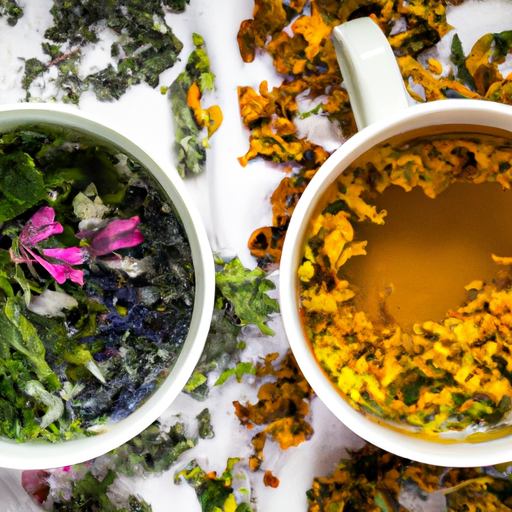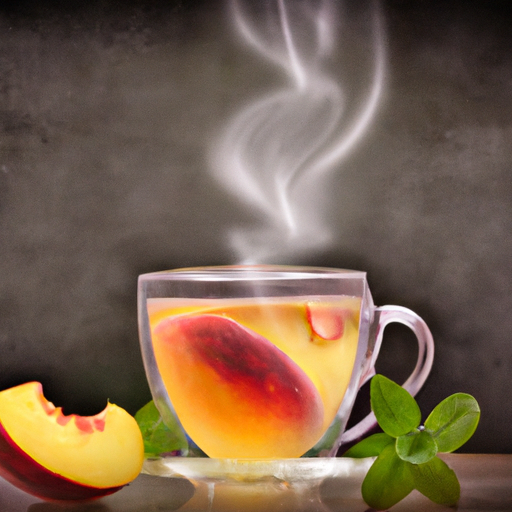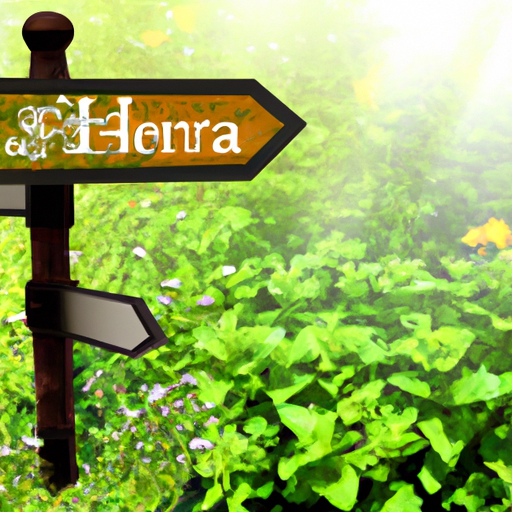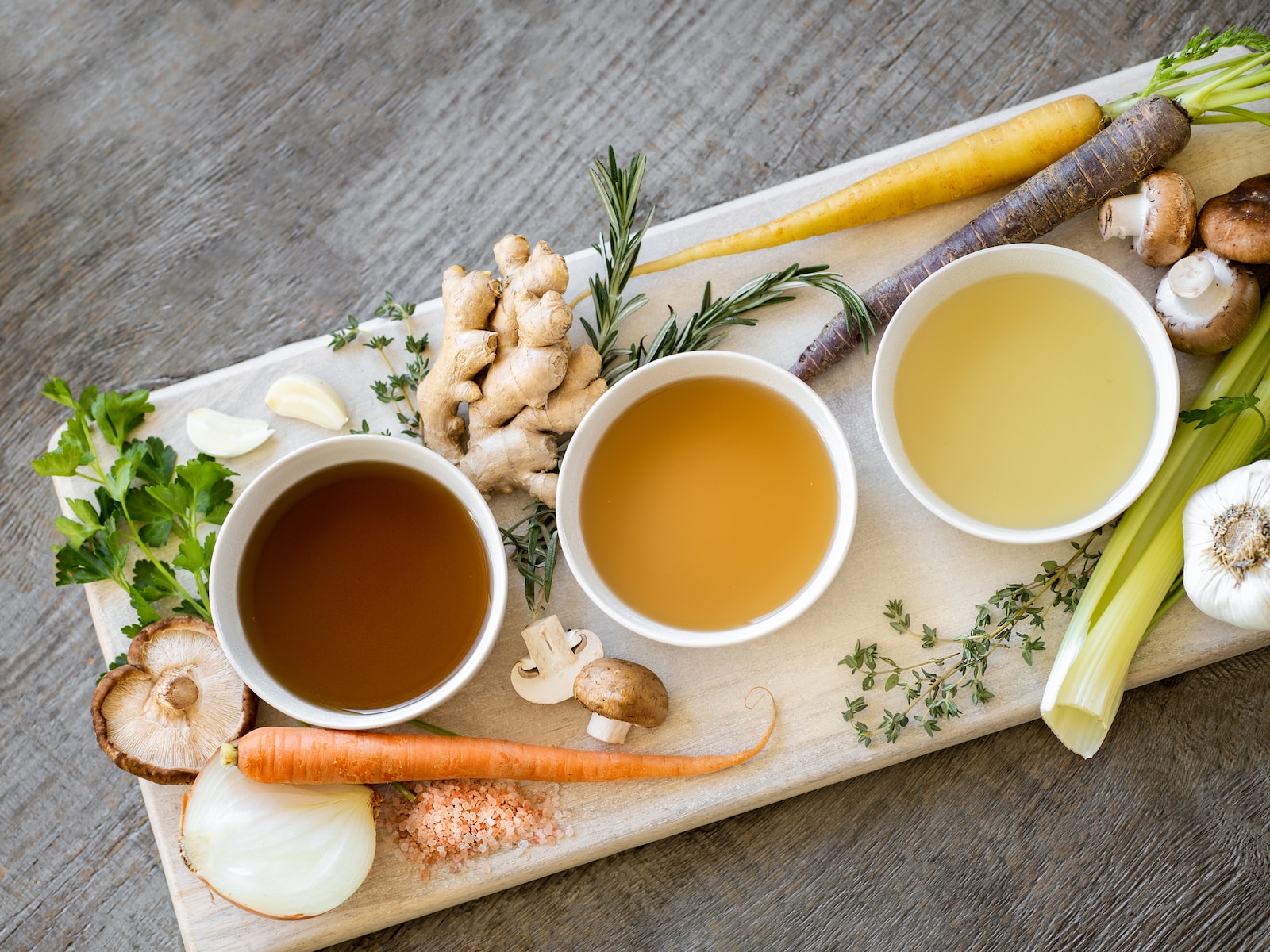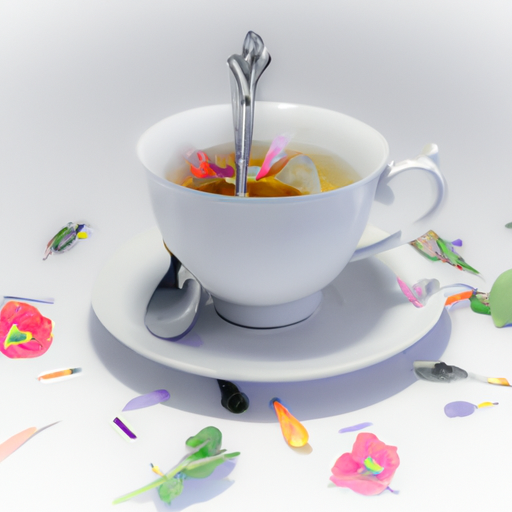As I sit here enjoying a hot cup of tea, I am reminded of the comforting hug it provides, calming both my body and spirit. Tea has been a cherished drink for centuries, filled with rich tradition and symbolism.
Yet, amidst the vast array of tea choices, the distinction between herbal tea and regular tea often leaves many puzzled. Like two branches of a tree, each type takes a different path, offering unique characteristics and benefits.
Herbal tea, derived from various plants, dances with vibrant flavors and medicinal properties, while regular tea, made from the Camellia sinensis plant, boasts an invigorating dose of caffeine and a diverse range of tastes.
Understanding the differences between these two enchanting brews is essential for tea enthusiasts seeking the perfect cup. So, let us embark on a journey of discovery, exploring the types of tea leaves used, the caffeine content, flavor profiles, health benefits, brewing methods, cultural significance, and the popular varieties of herbal and regular tea.
Key Takeaways
- Herbal tea is made from dried herbs, flowers, fruits, and spices, while regular tea is made from the Camellia sinensis plant.
- Herbal tea is caffeine-free, while regular tea contains caffeine.
- Herbal tea has medicinal properties and can help with anxiety, sleep, digestion, and immune support, while regular tea can improve mental alertness, boost energy, promote weight loss, and offer antioxidant benefits.
- Brewing methods differ between herbal tea and regular tea, with regular tea brewed with boiling water and herbal tea brewed with slightly cooler water for longer steeping times.
Types of Tea Leaves Used
Did you know that one of the main differences between herbal tea and regular tea lies in the types of tea leaves used?
Herbal tea is typically made from a variety of dried herbs, flowers, fruits, and spices, rather than the traditional tea leaves. Some common types of herbal teas include chamomile, peppermint, and hibiscus.
Regular tea, on the other hand, is made from the leaves of the Camellia sinensis plant. These leaves are harvested, dried, and processed to create different types of tea such as green, black, and oolong. The types of tea leaves used greatly impact the flavor, aroma, and health benefits of the tea.
Additionally, the brewing techniques for herbal tea and regular tea also differ.
Now, let’s move on to the next section about the caffeine content.
Caffeine Content
Herbal tea is a caffeine-free alternative to regular tea. Regular tea, such as black tea and green tea, contains caffeine. Herbal tea is made from a variety of plants, fruits, and herbs that do not naturally contain caffeine. This makes herbal tea a popular choice for those looking to avoid or reduce their caffeine intake.
Herbal tea is caffeine-free
When you drink regular tea, you get a boost from the caffeine, but with herbal tea, you can unwind and relax without any jitters or crashes. Herbal tea is known for its caffeine-free nature, making it a great choice for those who are sensitive to caffeine or looking for a beverage that can help them unwind.
Here are four types of herbal tea and the benefits of caffeine-free beverages:
-
Chamomile tea: Known for its calming properties, chamomile tea can help reduce anxiety and promote better sleep.
-
Peppermint tea: Refreshing and soothing, peppermint tea can aid in digestion and relieve stomach discomfort.
-
Rooibos tea: Packed with antioxidants, rooibos tea can support a healthy immune system and promote overall well-being.
-
Ginger tea: With its anti-inflammatory properties, ginger tea can help alleviate nausea and improve digestion.
Transitioning into the next section about regular tea containing caffeine, it’s important to note that while herbal tea offers a caffeine-free option, regular tea provides a different experience with its caffeine content.
Regular tea contains caffeine
Sipping on a warm cup of regular tea, I can feel the energizing buzz of caffeine coursing through my veins. Regular tea, unlike herbal tea, contains caffeine, which is a natural stimulant found in the leaves of the Camellia sinensis plant.
There are various types of regular tea, including black, green, oolong, and white tea, all of which contain different levels of caffeine. The benefits of caffeine in regular tea are vast. It can improve mental alertness, increase focus, and boost energy levels. Additionally, caffeine has been shown to enhance physical performance and promote weight loss.
As I continue to explore the differences between herbal tea and regular tea, it’s important to note that regular tea not only provides a caffeinated pick-me-up but also offers a wide range of flavors and aroma profiles.
Flavor Profiles
Indulging in regular tea offers a more robust and complex flavor profile that tantalizes your taste buds. The taste preferences associated with regular tea vary greatly depending on the type of tea and the region it comes from.
For example, black tea has a strong, bold flavor with hints of malt and astringency, while green tea offers a more vegetal and grassy taste. Additionally, oolong tea provides a balance between the floral and fruity notes.
Moreover, regular tea not only pleases your taste buds but also provides aromatherapy benefits. The fragrant aroma of tea leaves can promote relaxation and improve mood.
Transitioning into the subsequent section about health benefits, regular tea has numerous advantages that go beyond its flavor and aroma.
Health Benefits
Herbal tea offers a wide range of health benefits due to its medicinal properties and soothing effects. It has been used for centuries to alleviate various ailments such as digestion problems, anxiety, and insomnia.
Regular tea, on the other hand, is known for its high antioxidant content, which may promote heart health and reduce the risk of chronic diseases.
Both types of tea provide unique health benefits, making them valuable additions to a balanced and healthy lifestyle.
Herbal tea is known for its medicinal properties and soothing effects
With its natural healing properties, herbal tea can be a comforting remedy for ailments, like a warm hug on a cold winter’s day. Herbal tea is renowned for its medicinal properties and soothing effects. Here are three ways herbal tea can work its magic:
-
Calming properties: Herbal teas like chamomile and lavender can help relieve stress, anxiety, and promote relaxation. Sipping on a cup of herbal tea can provide a sense of tranquility after a long day.
-
Digestive aid: Peppermint and ginger herbal teas can soothe an upset stomach, ease indigestion, and reduce bloating. These teas can be a gentle and natural way to alleviate digestive discomfort.
-
Immune support: Some herbal teas, such as echinacea and elderberry, are known for their immune-boosting properties. They can help strengthen the immune system and ward off common illnesses.
Transitioning into the subsequent section, regular tea is rich in antioxidants and may promote heart health.
Regular tea is rich in antioxidants and may promote heart health
Sip on a steaming cup of regular tea and let its rich antioxidants warm your heart and invigorate your senses. Regular tea, whether black, green, or oolong, contains various types of antioxidants that can have a positive impact on your health. These antioxidants, such as catechins and flavonoids, help protect your cells from damage caused by harmful free radicals. They also have the potential to lower cholesterol levels, reducing the risk of heart disease. Studies have shown that regular tea consumption can lead to improved cardiovascular health and reduced inflammation. So, next time you brew a cup of tea, remember the potential health benefits it holds. Now, let’s dive into the fascinating world of different brewing methods.
Brewing Methods
To enhance the flavors of regular tea, you can experiment with different brewing methods. One key difference between herbal tea and regular tea is the brewing temperature. Regular tea is typically brewed with boiling water, while herbal tea is often brewed with slightly cooler water to preserve the delicate flavors of the herbs.
Additionally, steeping time also varies between the two. Regular tea usually requires a shorter steeping time of around 3-5 minutes, while herbal tea may need a longer steeping time of 5-7 minutes to fully extract the flavors and benefits.
Understanding the optimal brewing temperatures and steeping times for each type of tea can greatly enhance your tea-drinking experience.
Now, let’s explore the cultural significance of tea and how it has evolved over time.
Cultural Significance
Now that we’ve explored the different brewing methods for herbal tea and regular tea, let’s delve into their cultural significance.
Cultural practices surrounding tea vary greatly across different regions and countries, each with its own unique history and traditions. Tea has been a part of human civilization for centuries and holds a special place in many cultures.
From the Japanese tea ceremonies that emphasize mindfulness and tranquility to the British afternoon tea rituals that symbolize elegance and socializing, tea has played a central role in shaping cultural practices around the world.
The historical significance of tea cannot be underestimated, as it’s been associated with social gatherings, medicinal properties, and even political movements throughout history.
With this understanding of the cultural importance of tea, let’s now explore the popular varieties and flavors that both herbal tea and regular tea offer.
Popular Varieties
When it comes to popular varieties of tea, there are a few key distinctions to keep in mind.
Herbal tea offers a range of options such as chamomile, peppermint, hibiscus, and ginger, each with their own unique flavors and potential health benefits.
On the other hand, regular tea encompasses black, green, oolong, and white tea varieties, each with their own distinct taste profiles and levels of caffeine.
Exploring the world of tea can be an exciting journey, as you discover the diverse range of flavors and aromas that these different varieties have to offer.
Herbal tea includes chamomile, peppermint, hibiscus, and ginger
Herbal tea, which includes chamomile, peppermint, hibiscus, and ginger, offers a wide variety of flavors and health benefits. Did you know that chamomile tea can help reduce anxiety and improve sleep quality? It has calming properties that promote relaxation and restful sleep.
Peppermint tea, on the other hand, aids digestion and can relieve stomach discomfort such as bloating and indigestion.
Hibiscus tea is rich in antioxidants and can help lower blood pressure and cholesterol levels.
Ginger tea is known for its anti-inflammatory properties and can soothe nausea and relieve muscle pain.
Regular tea, on the other hand, includes black, green, oolong, and white tea varieties. These teas come from the Camellia sinensis plant and contain caffeine, which can provide an energy boost.
Regular tea includes black, green, oolong, and white tea varieties
Regular tea offers a delightful array of flavors and an invigorating energy boost with its various black, green, oolong, and white tea varieties. Each type of tea leaf undergoes different levels of oxidation and processing, resulting in distinct flavors and aromas.
Black tea, known for its bold and robust taste, is fully oxidized, while green tea is unoxidized, maintaining a fresh and grassy flavor. Oolong tea falls in between, with a partially oxidized profile that offers a balance of floral and fruity notes. White tea, the least processed of all, has a delicate and subtle taste.
To bring out the best in these teas, brewing techniques play a crucial role. Factors like water temperature, steeping time, and the amount of tea leaves used can greatly influence the flavor and strength of the final brew.
Frequently Asked Questions
How long should herbal tea and regular tea be steeped for optimal flavor?
For optimal flavor extraction, herbal tea should be steeped for 5-7 minutes, while regular tea should be steeped for 3-5 minutes. Steeping time affects the strength and taste of the tea, so adjust according to personal preference.
Are there any potential side effects or risks associated with drinking herbal tea or regular tea?
Potential side effects and risks of drinking herbal tea or regular tea are minimal. Both have been consumed for centuries and offer potential health benefits. However, moderation is key, and the recommended daily intake should be followed.
Can herbal tea and regular tea be consumed during pregnancy or breastfeeding?
During pregnancy or breastfeeding, it is important to take safety precautions when consuming herbal tea or regular tea. It is recommended to limit intake and consult with a healthcare provider for specific recommendations.
What are some common additives or ingredients found in herbal tea and regular tea?
One common additive in herbal tea is chamomile, which is known to promote relaxation and aid in digestion. Regular tea often contains caffeine, which can provide a boost of energy.
Is there any difference in the environmental impact of producing herbal tea and regular tea?
The environmental impact of producing herbal tea and regular tea differs due to the cultivation processes. Herbal tea often requires less water, pesticides, and fertilizers, making it more sustainable and environmentally friendly compared to regular tea production.
Conclusion
In conclusion, while both herbal tea and regular tea have their own unique characteristics, it’s important to understand the differences between them.
Herbal teas, made from various plants and herbs, offer a wide range of flavors and health benefits.
On the other hand, regular tea, typically made from the Camellia sinensis plant, contains caffeine and has its own distinct flavor profiles.
Understanding these differences allows us to appreciate the diversity of tea and choose the one that suits our preferences and health needs.
So, whether you prefer the soothing herbal blends or the invigorating taste of regular tea, there’s always a cup to satisfy your palate.

